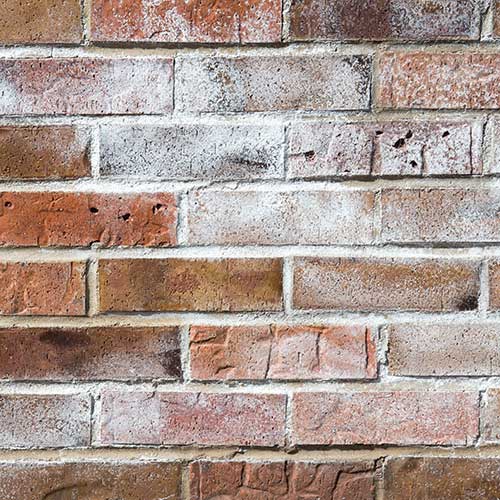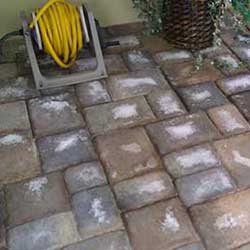

Efflorescence (aka. Calcium Carbonate) is the unsightly white film or buildup that can appear on any concrete surface. It can be as minimal as a light haze or it can be a heavier accumulation that has the appearance of snow. Efflorescence is not the result of careless construction practices by you or your contractor, or due to faulty materials used on the project. Efflorescence is a natural-occurring phenomena inherent in every concrete product (e.g. concrete pavers, retaining wall blocks, CMU blocks, poured slabs, etc.)
All concrete products, whether produced on a concrete block machine or formed and poured on site, will be at risk of efflorescence occurring over time. Once we understand more about how it forms, there are steps we can take to try and limit the formation of efflorescence or remove it once it forms.
The formation of efflorescence begins with the cement used in concrete mix. When water is added to a dry concrete mix, it reacts with the cement and starts a chemical reaction known as cement hydration.
During the cement hydration process, chemical compounds are created: Calcium Silicate Hydrate Gel (CSH Gel), Calcium Hydroxide (Ca(OH)2), ettringite, and monosulfoaluminate (AFm). Together, these compounds form a hardened matrix between the aggregates in the concrete mix. This matrix is what provides concrete its overall compressive strength, durability, and stability.
The Calcium Hydroxide that was created during the hydration process is the main culprit in the formation of efflorescence.
Concrete is a porous material, so when exposed to moisture (e.g. rainfall, irrigation, overflow, etc) it will allow water to penetrate and soak through. As water moves through the concrete, it picks up the Calcium Hydroxide and carries it to the surface of the concrete.
Once on the surface, the Calcium Hydroxide reacts with Carbon Dioxide (CO2) in the atmosphere, in turn forming the water-insoluble white substance Calcium Carbonate (CaCO3)... aka Efflorescence. This is the same solid that is found in rocks like limestone, marble, and chalk, as well as a major component of seashells and eggshells.
The formation of efflorescence on a concrete product will continue to appear until all the available Calcium Hydroxide within that concrete product has been depleted.
It should also be noted that Calcium Hydroxide is more able to be driven out of the concrete when water moves slowly through the concrete. Because of this, aside from the increase of water during the rainy season, efflorescence is more likely to appear during the colder months from Late Fall-Early Spring as opposed to the warmer months of Late Spring-Early Fall.


Because efflorescence is insoluble in water, and can be an extremely hard substance, you will normally not be able to remove it with water and agitation alone. The best solution for removing efflorescence from your concrete product would be to use any one of the many specified products designed to dissolve and break down the Calcium Carbonate, allowing it to be rinsed away and ensuring a clean and stain-free surface.
Whether choosing an efflorescence-specific product, general masonry detergent, or caustic product like muriatic acid; it is advised to closely follow the manufacturer’s suggested guidelines for application. RCP Block & Brick has a variety of available masonry cleaners and efflorescense removers available. Please contact us for more information.
The formation of efflorescence is inherently a part of all concrete products. There is currently not a 100% effective way to prevent efflorescence from ever forming as it will always have the potential to present itself if there is Calcium Hydroxide available within the concrete to create it. There are some steps you can take to try and limit efflorescence from presenting itself in your concrete pavers or retaining wall projects: